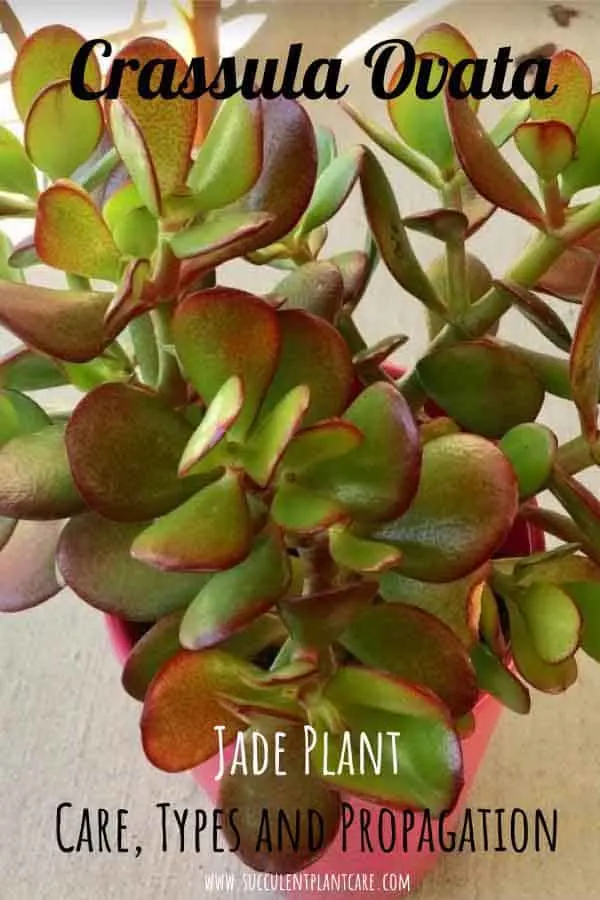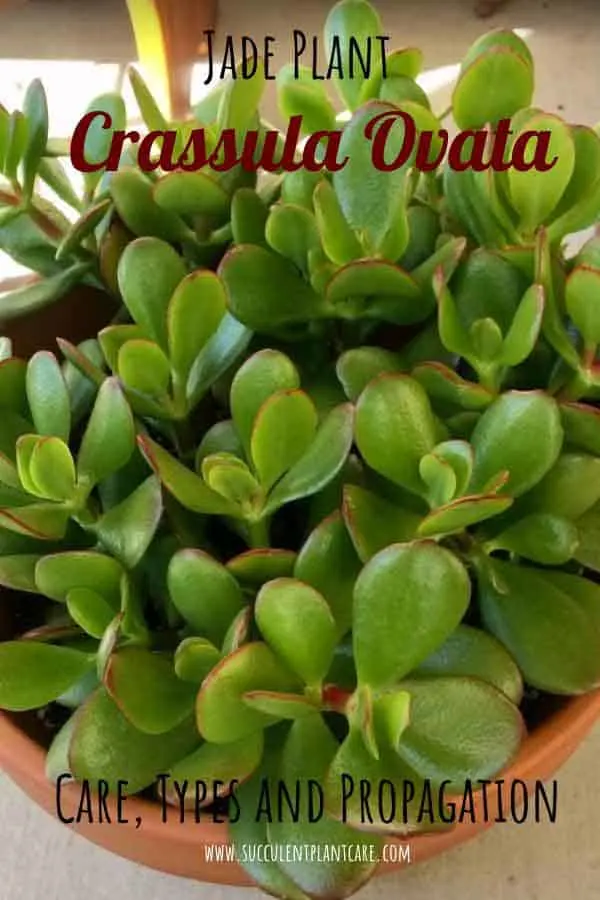Jade plants might be one of the most common and popular succulent plants out there. Jade plants belong in the Crassula family, a large genus of succulent plants. These plants are native to South Africa and Mozambique.
They are recognized for their thick, fleshy, shiny, smooth leaves that grow in opposite pairs. Leaves range in color from dark jade green in the shade to red on the edges when exposed to direct or full sunlight. Their branches thicken with age.
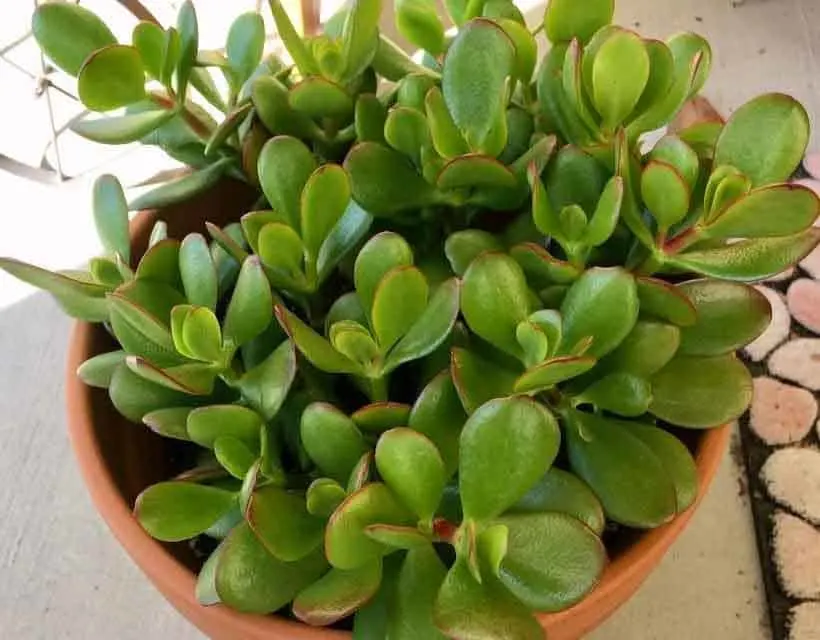
Known to some as money tree, lucky plant, or friendship tree, you can understand the reason for its popularity based on its common names. In some cultures, jade plant is considered auspicious and can be commonly found in store fronts, businesses, as well as people’s homes. Jade plants are forgiving plants and easy to care for.
I’ve been growing jade plants for years and consider them to be one of my favorites. They are resilient and hardy, which make them a great choice for a starter or beginner plant.
Are Jade Plants Indoor or Outdoor Plants?
Due to their easy going nature, jade plants can do well both indoors or outdoors. I’ve personally grown my jade plants outdoors, but then again, I keep all of my succulent plants outdoors.
I know a lot of people that keep their jade plants indoors and they do just as well. The key is in how you care for the plant.
How to Care for a Jade Plant:
Indoor Lighting Conditions
If kept indoors, make sure the jade plant is receiving adequate sunlight. Jade plants kept indoors or in the shade maintain a deep, emerald or dark green color on their leaves. You’ll know if they are not receiving adequate sunlight by the way they grow.

They will start stretching towards the sun and become long and leggy, a process called etiolation when they don’t receive enough sunlight. If kept indoors, find a bright spot in your home. If you find that the jade is not doing well and appears to be stretching, you need to move it to a brighter location or consider using grow lights to provide adequate lighting.
Generally speaking, jade plants, like most succulent plants, need at least 5-6 hours a day of bright sunlight to grow properly. If kept by the window that receives bright intense sun, especially afternoon sun, the leaves might experience sunburn (brown spots) until acclimated to the intense sunlight. To avoid this, gradually increase the amount of intense sun it receives.
Outdoor Sunlight Conditions
Jade plants prefer plenty of sun, but direct sunlight, especially intense afternoon sun, can burn the leaves of the plant. You will see sunburned spots on the leaves (brown spots) when this happens. To prevent this from happening, you can move the plant to a location where it receives plenty of bright morning sun as opposed to afternoon sun.
Morning sun is less intense than the afternoon sun and is preferred by most succulents. If you can’t move the plant and it receives full afternoon sun, try to provide some shade until it gets used to the intense sun. This can be done by placing it next to a taller plant or tree to provide some shade, or placing a piece of furniture such as a table or chair next to the plant to serve as shade.
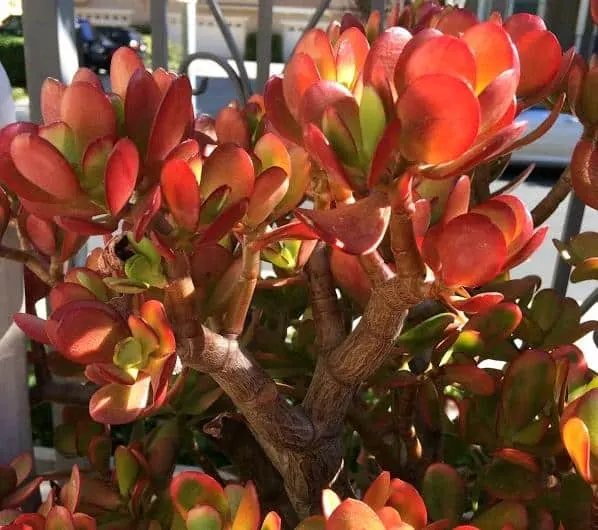
The leaves of this jade plant have turned a reddish hue, especially around the edges due to exposure to full sun.
Increase sun exposure slowly to prevent sun damage. Once acclimated to full sun, it should be able to withstand the intense afternoon heat. But even an acclimated mature jade plant can still suffer from sunburn during a heatwave, or when the temperature gets intensely hot over the summer.
When this happens, it’s usually not detrimental to the plant and the plant usually recovers without a problem. The sunburnt leaves will eventually fall off as new leaves grow. Jade plants exposed to bright afternoon sun will have a reddish tint on their leaves, especially the edges of the leaves.
Potting Medium
Jade plants prefer a potting mix that is fast draining. They do not like to sit in wet soil for too long. If the soil stays constantly wet, the plant becomes susceptible to fungus, diseases, and root rot.
Use a well draining potting mix. You can augment the potting mix by adding pumice or perlite to the potting or cactus mix. I usually use a commercial cactus mix and combine it with equal parts perlite (1:1 ).
You can make your own cactus potting mix by adding course sand, pumice or perlite to increase drainage. Please click on “Best Soil and Fertilizers for Succulents” for ingredients and ideas on how to make your own succulent potting mix.
Watering
Proper watering techniques go hand in hand with the right potting mix. Just as the soil needs to be fast draining, jade plants do not like to sit in water or wet soil too long. It is important to have the right potting mix and watering techniques for the plant to thrive.
As a rule of thumb with watering jade plants, water only when the top inch of the soil feeds dry to touch. Wait for the soil to dry out in between waterings. This is largely dependent on the climate you live in and the weather.
I live in a very dry climate and since my jade plants receive plenty of intense afternoon sun, I water them once every 7-10 days during the summer months, and more during intense heat waves. I cut back on watering during cooler months to once every 10-14 days or so.
Watering would differ if you live in a humid and cooler climate. You wouldn’t need to water your jade plant as much. I find it is better to err on the side of caution when watering, especially if you are a beginner.
Jade plants are very forgiving plants. Since they store water in their leaves and trunks, they can go for a long time without water, especially mature jade plants. I forget to water my plants a lot and I start noticing their leaves begin to flatten, meaning their water reserves are starting to run low.
I just give them a good drink and they perk right back up. I also noticed that they love rainwater. Rainwater makes them very happy so I try to collect rainwater whenever we get rain around here, which is not very often.
Watering indoors also differ slightly from outdoors because the temperature and light are more controlled. But the same rule still applies–water when the top inch of the soil feels dry. You may not need to water as much indoors because the sunlight is not as intense.
Fertilize
Keep in mind that jade plants are not finicky plants. I consider them to be one of the hardiest succulents plants. If the potting mix is fresh, fertilizing is usually not necessary.
Once the plant has been sitting in the same potting mix for a couple of years without repotting, then you’ll need to replenish the nutrients that the plant would otherwise be getting from fresh soil. You can use a standard balanced fertilizer for houseplants or a specialized fertilizer designed for succulents and cacti. Dilute the amount of fertilizer recommended on the package to ¼ or ½ strength.
Be wary of overfeeding jade plants, as they are not heavy feeders and do not require that much. It is best to feed during the growing season which is in the spring, summer and fall seasons. Fertilizing about once a month during the growing season is a good place to start. During the active growing season, you can fertilize as often as every watering, with the fertilizer diluted to ¼ or ½ strength.
Decrease fertilizing as the end of growing season approaches around mid-fall. To read more about fertilizers for succulents, please click on “Best Soil and Fertilizers for Succulents.”
Getting Your Jade to Bloom
While getting your jade plant to bloom is not a priority, it is definitely a treat to see happy flowers blooming from it. I have a big jade plant that blooms every year. There is no exact science on how to get them to bloom.
Generally, if you keep your plant healthy and happy by providing proper care and nutrients as mentioned above, the plant will naturally bloom when it’s ready. To encourage blooms, the plants need to be kept in an environment that mimics their natural habitat. This can be achieved by keeping them cool and dry in the winter months.
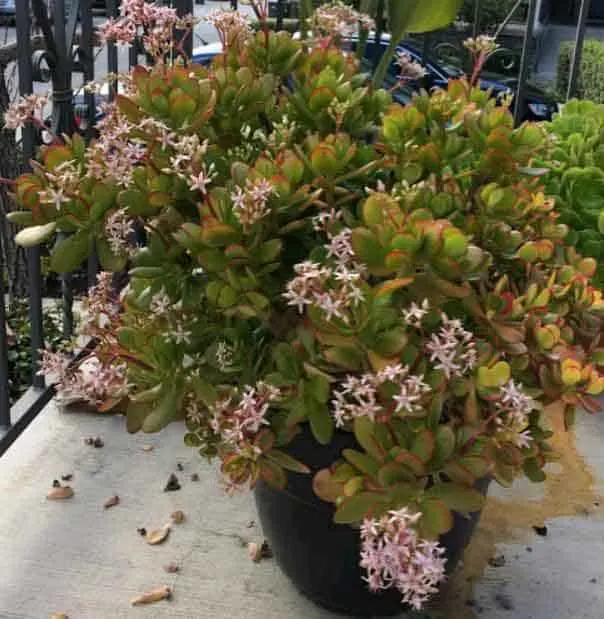
You need to decrease watering the plant to a minimum and only water when the soil is dry but not bone dry. Keep the temperatures cool during the winter months, somewhere between 35-44⁰F (1.5-7⁰C). I keep mines outdoors all year long, but the weather is mild where I am and these plants can withstand minor frosts here and there.
For more on this topic, please click on “How to Get Succulents and Cacti to Bloom”.
Other care articles specific for Jade Plants
Jade Plants Wrinkled Leaves – Jade Plant Falling Over – Jade Plant Leaves Turning Yellow – Jade Plant Branches/Leaves Shriveling/Drooping – Jade Plant Care, Propagation and Types
How to prune a top heavy Jade Plant?
Jade plants retain a lot of water mainly in their leaves, when they become top heavy they tend to tumble and make a mess. No need to worry though, Crassula Ovata specially the regular one is a very versatile plant. When you cut their leaves or stems just above a node(connection with stem segments) they grow right back in no time. When you cut the stem they typically grow back in twos. See the photos below.

It’s actually an opportunity to style when you prune. You can decide where you want your jade to grow a branch or two. A branch will typically grow where the leaf is so decide accordingly. You can decide to cut the node that will allow you to grow branches to the left and right of the plant or you can also decide to cut the node that will allow you to grow branches forward and back.

When you prune your jade plant, you could also decide to prune down to one set of leaves every time you prune. These pruning process will really thicken up your leaves and make your jade plant look very compact. This strategy is used by many jade plant bonsai lovers.

How To Propagate Jade Plants:
Propagation is the process of creating new plants from already existing plants, either through leaf or stem cuttings, beheadings, and seed collection. Jade plants are one of the easiest plants to grow and propagate.
Here’s A Step-by-Step Guide on How To Propagate Jade Plants:
Step 1-Take a stem or leaf cutting. Make sure to take the whole leaf including the base or the leaf will not survive.

Step 2-Put the cuttings aside to dry for a day or more until the cut part has completely healed. (Optional: dip the cuttings in rooting hormone).
Step 3-Stick the cuttings in a well draining potting mix. You can use cactus soil mixed with perlite or pumice (1:1). Some people like to throw in coarse sand for added drainage. You can either stick the leaf cuttings in soil or lay them flat on the soil.
Step 4-Keep away from direct sunlight. Spray or water the soil every few days or when dry.
Step 5-You will notice roots start to form in about two weeks time. The stem cuttings will be fully rooted in about 6-8 weeks. Tug at the stem and if they do not come off easily from the soil, the stems have rooted.
Leaf cuttings take longer because you need to wait for a new plant to sprout and for it to grow bigger. The whole process may take anywhere from 8 weeks to a few months from leaf propagation.
Step 6-Increase sunlight once the plants are established. Decrease watering to once every ten days or so once the plants are mature.
I’ve propagated jade plants in different ways, from leaves, stem cuttings, even from water propagation. All of them worked for jade plants, but my favorite method of propagation is through stem cuttings because it is the easiest and I get the highest success rate from it.

I have a lot of useful information and ideas on how to propagate jade plants in different posts. Please click on these links to learn more about propagation:
“What is Succulent Propagation? My Success Stories”
“Water Propagation for Succulents: A How-to Guide”
“How To Propagate Succulents: A Step-by-Step Guide”
Types of Jade Plants
There are numerous varieties of Jade Plants. These are some of the most common and popular varieties:
Crassula Ovata (Jade Plant)
Perhaps the most popular and common type of jade plant. Native to South Africa and Mozambique, they are known for their thick, fleshy, shiny, smooth leaves that grow in opposite pairs. Leaves range in color from dark jade green in the shade to red on the edges when exposed to direct or full sunlight.
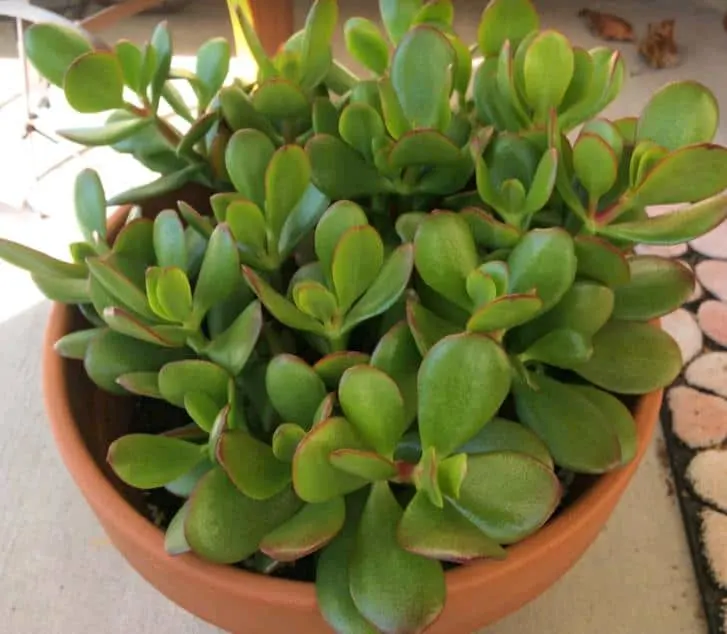
Crassula Ovata ‘‘Hummel’s Sunset’ (Golden Jade Plant)
This variety has a beautiful golden yellow-green hue to their leaves. Care is similar to the common green jade plant.

Crassula Arborescens (Silver Jade Plant)
Crassula Arborescens (also known as Silver Jade, Chinese Jade, Money Plant) is native to South Africa. Their distinguishing features are their ‘silver dollar’ leaves, which are round and silvery-green in color with reddish edges.
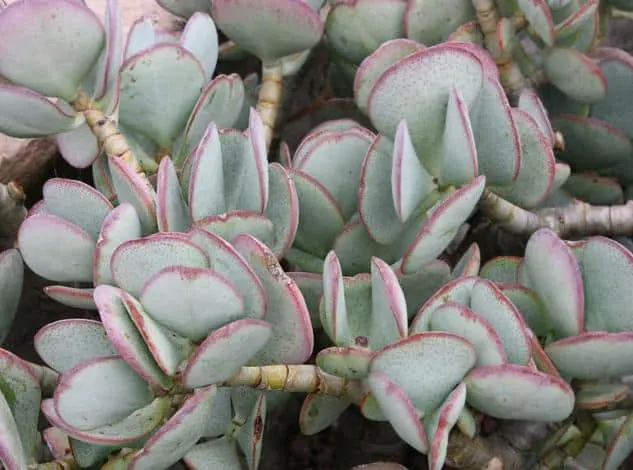
Crassula Ovata ‘Crosby’s Compact’ or ‘Crosby’s Dwarf (Dwarf Jade)
This variety grows much slower and stays small compared to the other jade varieties. Care is similar to other jade plants. Dwarf jade have smaller leaves and branches. Their leaves are yellow-green in color that turn reddish especially on the edges when exposed to full sun.
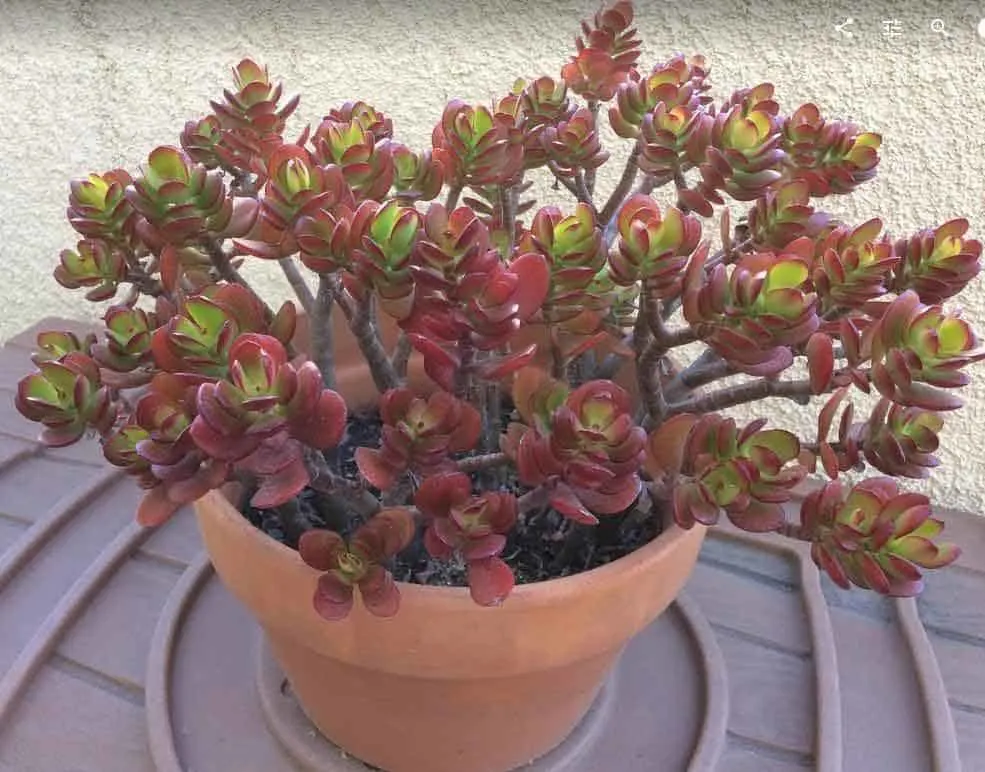
This is my dwarf jade plant that I’ve had in this pot for years. It is a very slow growing plant compared to the more common jade plant. As you can see, the leaves and branches are smaller versions of the other plant. The leaves have turned red especially on the edges because of full sun exposure.
Crassula Ovata ‘Gollum’ (Gollum Jade, Hobbit Jade, Ogre Ears)
If you’re familiar with the character Gollum from ‘Lord of the Rings’, then just the name of this jade plant will surely bring a smile to your face. Judging from this plant’s other common names (Hobbit, Ogre Ears), you can tell that it has unusual physical traits. Unlike other jade plants with flat, heart-shaped leaves, Gollum Jades have finger-like tubular leaves and concave tips.
The tubular leaves range in color from light to deep green and the tips are tinged with red. The reddish hue on the tips intensify with sun exposure and cooler temperatures.

Crassula Ovata ‘Variegata’ (Variegated Jade Plant)
Variegated Jade plants, also known as ‘Lemon & Lime’ are distinguished for their light green, pale yellow and ivory colored striped leaves. Like many jade varieties, Variegated Jade plants’ leaves can turn pinkish red at the tips when exposed to plenty of sunlight. These are fast growing plants and branch out as they grow. They produce white, star-shaped flowers.
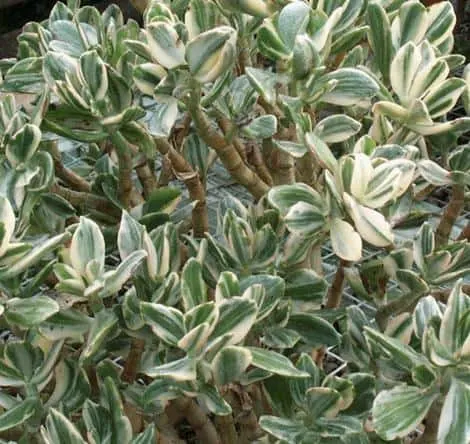
Portulacaria Afra (Elephant Bush, also called Dwarf Jade)
Although these look similar to jade plants, they are not related. I included this plant here because people mistake it for the actual jade plant all the time. I’ve made the same mistake in the past.
Native to South Africa, they serve as food for elephants in their native habitat and can grow up to 20 feet tall. They have glossy green leaves that start out as a small bush and eventually grow tall and tree-like. These plants are very easy to grow and propagate. They are also called Dwarf Jade and is a favorite among bonsai tree growers.
I wrote a separate post specific about Portulacaria Afra – Elephant Bush. I go into more details about this plant.
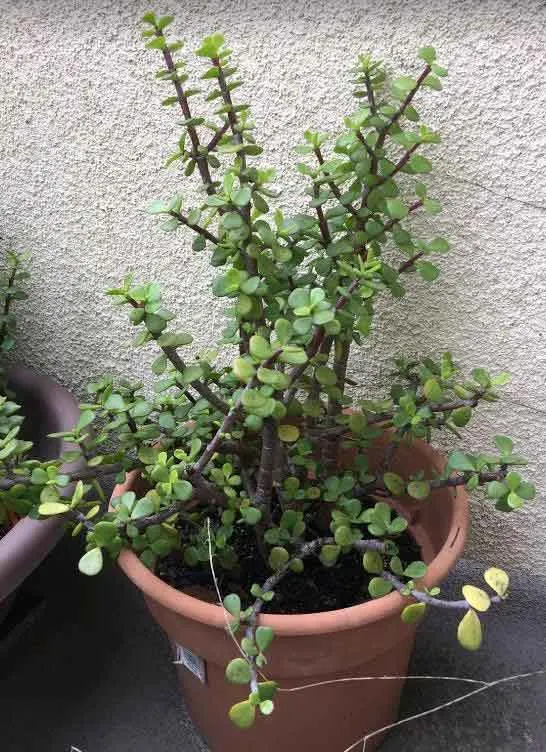
Are Jade Plants Lucky?
Known in some cultures as a ‘lucky plant’, jade plants are considered auspicious in Feng Shui. The deep green leaves resemble the mineral jade which has long been used in Feng Shui as a symbol of wealth and prosperity. The mineral jade is also associated with healing, balance and harmony.
Jade’s heart shaped leaves and deep green color are highly desirable in Feng Shui and are thought to attract money and wealth. Jade plants are also referred to as ‘friendship trees’ and are commonly given as gifts to friends and family for housewarming and such. You can definitely consider yourself lucky if you own one or more of these beauties.
Are Jade Plants Toxic?
Jade plants are mildly toxic to cats and dogs. It is unknown what substance in jade plants causes toxicity. Symptoms include nausea, vomiting, depression, incoordination, lethargy when consumed.
To find out more about toxic plants, the ASPCA’s (American Society for the Prevention of Cruelty to Animals) website provides valuable information and a comprehensive list of toxic and nontoxic plants for cats, dogs, and other house pets.
If you suspect poisoning, contact your local veterinarian immediately or the ASPCA Animal Poison Control Center at 888-426-4435.
Hope you like our article please share pinterest!
